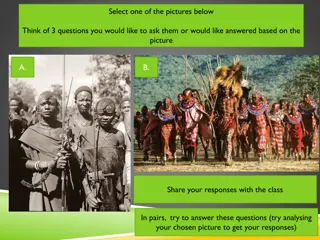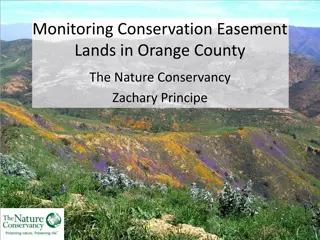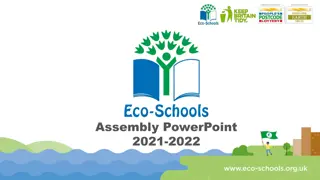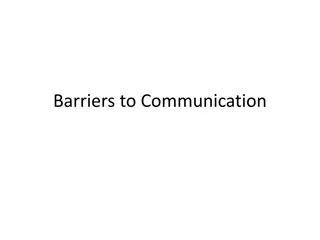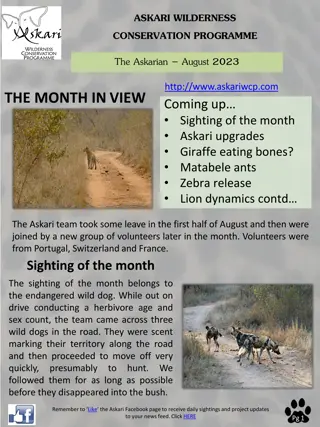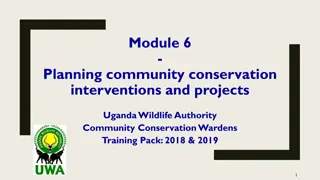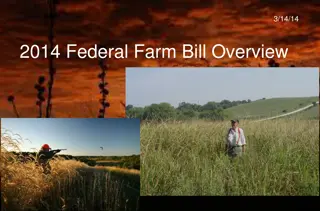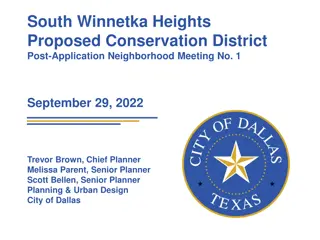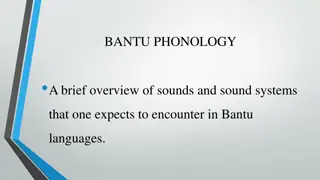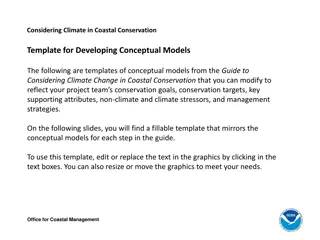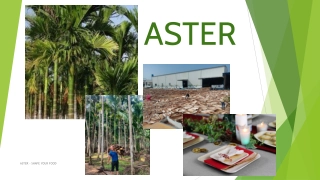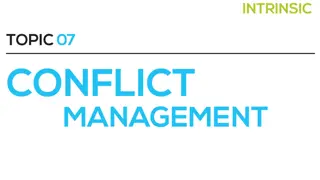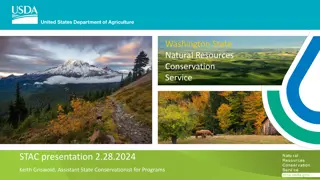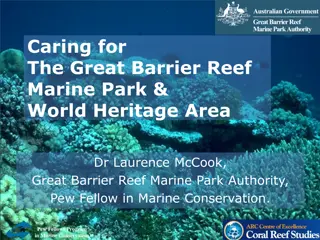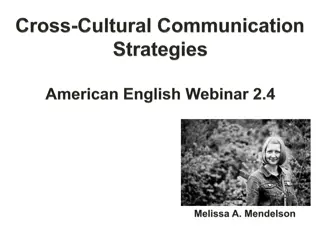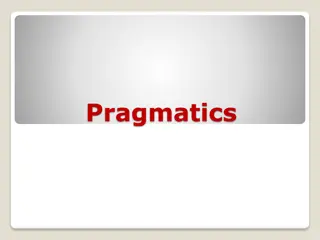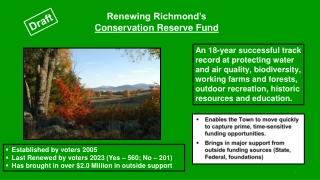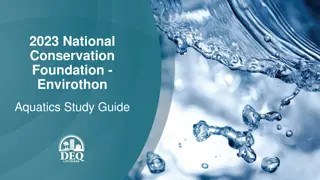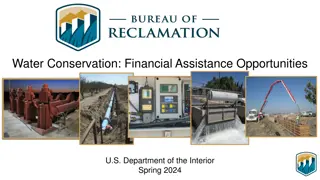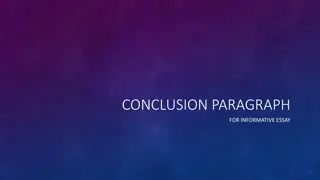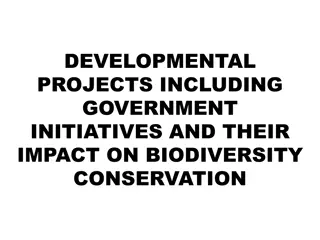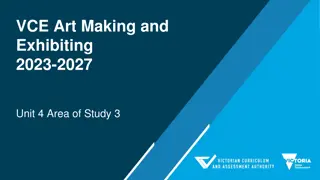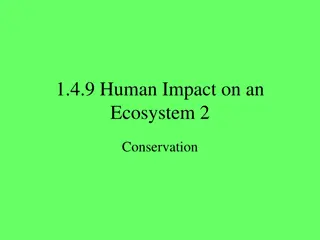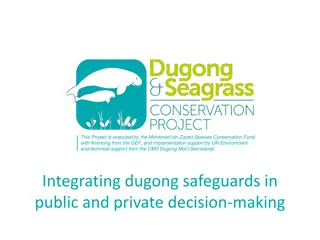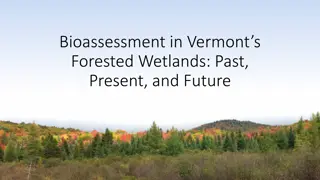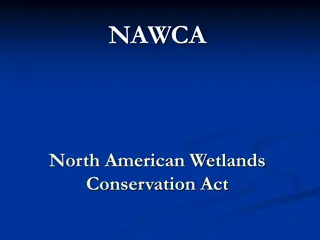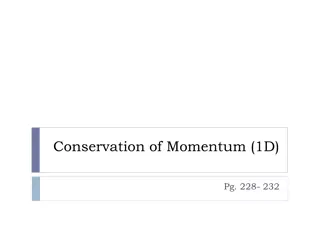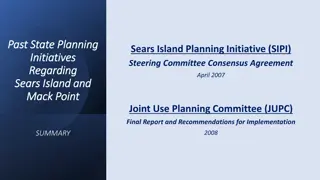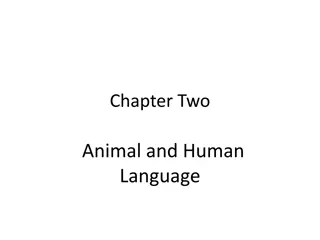Strategies for Online Eco-Linguistic Communication in Maasai Mara Conservation
Maasai Mara faces threats from human encroachment, prompting conservation efforts. This study explores online eco-linguistic strategies for engaging the public in conservation activities. The importance of language in online communication to achieve ecological harmony is highlighted, emphasizing ecolinguistics as a crucial tool for conservation organizations in this diverse ecosystem.
Download Presentation

Please find below an Image/Link to download the presentation.
The content on the website is provided AS IS for your information and personal use only. It may not be sold, licensed, or shared on other websites without obtaining consent from the author. Download presentation by click this link. If you encounter any issues during the download, it is possible that the publisher has removed the file from their server.
E N D
Presentation Transcript
Exploring Online Eco-linguistic Communication Strategies on the Conservation of Maasai Mara Game Reserve by Khadohi Bonface Isalambo
INTRODUCTION Maasai Mara is situated in south-west Kenya and is one of Africa s greatest wildlife reserves and forms Africa s most diverse, incredible and most spectacular. The Maasai Mara ecosystem is threatened by human encroachment and activities. Conservation groups and agencies have come up with strategies to engage their environmental publics. Organizations have increasingly taken up online communication due to the rapid growth of internet usage. In a sector report by Communications Authority in Kenya in 2014,Kenyan Internet users rose to 26.1 million from 10 million in 2011-43.7 % of the total population. The report placed Kenya ahead of South Africa and Nigeria in terms of Internet usage though behind Egypt. Language is crucial for organizations in communicating to their publics through the online communication and accomplishing their conservation efforts and ecological harmony.
CONTEXTUALIZING ECOLINGUISTICS There are two levels of linguistic studies-micro and macro. The micro linguistics level deals with the structure of the language system and includes levels such phonology,morphology,syntax and semantics. The linguist s aim is to analyze language with an explicit attention to the linguistic features as they are structured in the system. The macro linguistics level deals with the application of language system or how the role of the individual within the language system. At the macro level linguistic behavior is explained in terms of how it overlaps with other disciplines such as sociology,psychology,biology and ecology. Examples are sociolinguistics,psycholinguistics,biolinguistics,ethnolinguistics, forensic linguistics and ecolinguistics.
DEFINING ECOLINGUISTICS Language ecology is the study of interactions between any given language and its environment (Haugen,1970) Ecolinguistics consists of the following: a) questioning the stories that underpin our current unsustainable civilization; b) exposing those stories that are clearly not working, that are leading to ecological destruction and social injustice; and c) finding new stories that work better in the conditions of the world that we face (Stibbe,2014). Ecolinguistics is a) The study of the processes and activities through which human beings-at individual,group,population and species level-exploit their environment in order to create an extended sense saturated ecology that supports their existential trajectories as well as b) The study of the organismic, societal and ecosystemic limits of such processes-the carrying capacities for upholding a healthy existence for both human and non human lives at all levels.
RATIONALE FOR ONLINE ECOLINGUISTICS STUDY that there as a mismatch between the contours of language and the contours of the environment. that most environmental professionals (for instance EIA writers) and environmental pressure groups ignore linguistic aspects of the environment. that the diversity of languages and the diversity of natural resources are interdependent . that there has been a marked increase in Internet usage (43.7% of total population) making it possible for organizations to engage their environmental publics. that this paper seeks to carry out a Linguistic Impact Assessment (LIA) of online communication of Maasai Mara conservation efforts through an ecolinguistic approach. this paper critically appraises the ways in which the environment, sustainability and ecologies within the Maasai Mara Game Reserve are presented, represented and constructed through various forms of language via online communication.
LINGUISTIC DISCOURSES ANALYSED FROM AN ECOLINGUISTIC PERSPECTIVE advertising (Hogben 2009, Slater 2007)]], economics (Stibbe 2005, Halliday 2001), environmentalism (Alexander 2010, Benton and Short 1999, Harr et al 1999), natural resources (Meisner 2007, Kurz et al 2005), energy (Russell et al 2011)animals(Stibbe 2012a, Goatly 2006, Glenn 2004), ecotourism (Milstein 2011, 2008), the concept of nature(Knight 2010, Hanson 2006), climate change (Doulton and Brown 2009Ihlen 2009) and sustainability (Kowalski 2013). That a majority of Kenyans are engaged in online communication (43.7%) yet its potential for communication is under researched.
THEORETICAL FRAMEWORK CRITICAL ECOLINGUISTICS exposes how common sense assumptions built into the prevailing discourses of a society and contribute to unequal relations of power. The focus is on discourses that have (or potentially have) a significant impact not only on how people treat other people but also how they treat the larger ecological systems that life depends on. The discourses are analysed by showing how clusters of linguistic features come together to form particular world views or cultural codes The criteria that worldviews are judged by are derived from an explicit or implicit ecological philosophy (or ecosophy). The studies aims to expose and draw attention to discourses which are appear to be ecologically destructive or work against principles of ecosophy. Alternatively, they aim to promote discourses which could potentially help protect and preserve the conditions that support life or are aligned with principles of ecosophy . The studies seeks to raise awareness of the role of language in ecological destruction or protection, informing policy and educational development, or providing ideas that can be drawn on in redesigning existing texts or producing new texts in the future.
ECOSOPHIES Cornutopianism- considers human ingenuity and ever advancing technology to overcome environmental resources and roots for industrial progress for human benefit exclusively (Lomborg 2001, Ridley 2011). Social ecology- humans will not stop dominating nature and treating it as a resource until we stop dominating each other and treating each other as resources (Bookchin 2005). Ecofeminism- locates the roots of ecological crisis in domination, but particularly focuses on the parallels between men s domination of women and the oppression of animals and the environment (Pandey 2011). Deep Ecology- based around recognizing the intrinsic worth of plants, animals, forests, rivers, i.e., their value beyond direct, short-term use for humans(Dregson and Young 1996).
ECOSOPHIES DEVELOPED BY MOVEMENTS Transition -based on a philosophy of resilience as a key aim, as both climate change and the depletion of oil lead to an inevitable decline in the ability of the Earth to support human life (Hopkins,2008) The Dark Mountain Project The Dark Mountain Project -aims at generating new stories for survivors to live and consider humans as part of the natural world rather than conquers of it (Kingsnorth and Hine 2009). Green Resistance- views industrial civilization as evil due to the damage and suffering it causes both humans and other species, and rather than waiting for it to destroy itself aims to hasten its destruction through carefully planned sabotage (McBay et al 2011). Voluntary Human Extinction Movement- it would be better for one species (homo sapiens) to go extinct (voluntarily through a global decision not to have children) rather than the millions of species that humans are causing to go extinct(VHEMT 2013). Ecolinguists can choose, combine or develop their personal ecosophy
METHODOLOGY The study adopted a descriptive design. The study employed a stratified sampling procedure using the following strata to ensure representativeness of Web discourse: Websites (Web 1.0) i. Blogs ( Web 2.0) ii. Facebook Accounts (Web 2.0) iii. The study analyzed 5 samples from each strata for organizations dealing with conservation of the Maasai Mara conservation. The various ecolingusitic concepts were applied to both the asymmetrical (Web1.0) and symmetrical (Web 2.0) media of communication.
ANALYSIS AND DISCUSSION-BLOGS The study reveals dominant discourse of English language in nearly all the media analyzed. Although Kiswahili was captured as a medium, the content has not been developed. Several self directed movements struggling for justice and equity were identified-Anne Kent Taylor Fund (AKTF) Blog established to deal with bush meat poaching after experience with wounded warthog which was treated and later named Sir Francis Bacon. Blogs reveal several ongoing projects focus on wildlife conservation but fails to address issues of consumerism. For example the predator proof animal enclosure funded by AKTF is expected to achieve sustainable biodiversity conservation fails to point out that the enclosures shall be constructed using timber which will consequently encourage wanton destruction of forests and militate against its initial objectives. Elephant Voice Blog demonstrated Deep Environmentalism through use of powerful imagery of personification. The Elephant is given all human attributes ( Elephants are extraordinary, learn from others, large brained and intelligent). The Ecosophy within the blog is to root for biocentric language to replace anthropocentric language.
ANALYSIS AND DISCUSSION -BLOGS Critical language awareness is most effective in the Elephant Voices Blog raises awareness of the discourse of economic growth among economists and politicians who use (and therefore reproduce) the discourse of the proposed new roads that were supposed to go through Serengeti Park through the title The road to destroying natural ecosystems . The study revealed discourses which resonate with and are aligned with the ecosophy of the analyst The powerful imagery of the elephant resonates with the ecosophy of Deep environmentalism The blogs are devoid of advertisements which can be attributed to duplication of the same in the real life situation thus discouraging excess consumption-consumerism Linguistic features can be combined in ways which express cultural codes. The combination of the elephant imagery (large brained,intelligent,social) creates Deep Environmentalism . Extensive use of self mentions (I,We) indicating authors presence in relation to conservation and the community publics
ANALYSIS AND DISCUSSION-FACEBOOK ACCOUNTS This emerged as the most interactive medium Facebook hinges heavily on multimodal communication-text and images. positive discourses which encourage human wildlife co-existence in the Maasai Mara as practiced by the Maasai and destructive discourses rising human population, shifts to agriculture, sub-division of land (leading to migration corridors being blocked) as captured in the Cambridge University Wildlife Conservation Facebook account . Evidence of the co existence is given through multimodal texts. Some discourses bring out inequalities within the camping sites. (camps inside Mara reserve are not allowed to do night game drives or walks but did you know at Cottars 1920s Camp Maasai Mara we do night game drives? ) Rhetorical persuasion achieved through multimodality . it achieves the ecosophy of Deep Environmentalism
ANALYSIS AND DISCUSSION-WEBSITES Websites provide for asymmetrical communication and are not as interactive as blogs and facebook accounts. The translation efforts in the Karen Blitz camp webiste simply reinforce homogenization of anthropocentricism, monolingualism and monoculturalism and globalization because they fail to take into account the social, political and historical contexts between languages negates the purpose of translation- For instancMoran (boy) instead of youth. In the process of describing their publics, the Maa community, the Karen Blitz Camp Web page, the modernity and traditional dialectic so that the Maa culture is presented as a commodity. Commoditization works against ecological harmony. (Although the benefits of modern life such as healthcare clinics, schools and access to safe water can be seen throughout the area; life still offers many challenges.) In contrast, the Maasai Mara Conservancies website gives the Maasai narrative devoid of the patronizing attitude. A detailed description is given accompanied with multimodal communication (Photos with requisite captions). Extensive use of engagement markers- imperatives in the Maasai Mara Conservancies Website ( get involved) urging publics to participate in the conservation efforts.
CONCLUSION The linguistic discourses used in the Maasai Mara Conservation efforts are anchored in the ecosophies of Deep Environmentalism and Biocentricism The study has exposed and drawn attention to discourses of commoditization, economic growth ,consumerism which appear to be ecologically destructive and work against the principles of Deep Environmentalism and Biocentricism. The study has also drawn our attention to positive discourses devoid of advertisements and help protect and preserve conditions of life and are aligned with the principles of Deep Environmentalism and Biocentricism.
RECOMMENDATIONS That the communication departments of conservation groups should redesign new texts that are not ecologically destructive. That in addition to Environmental Impact Assessment tests (EIA) all media of organizations should be subjected to Linguistic Impact Assessment tests (LIA) to avoid ecologically destructive texts or texts that create ecological disharmony.


